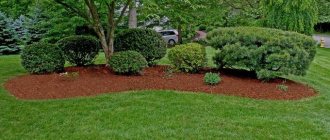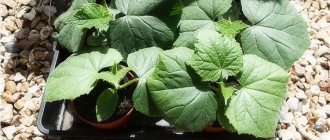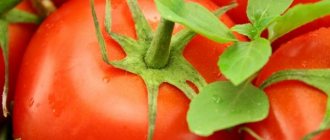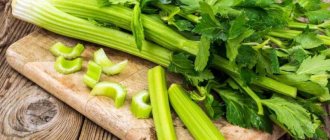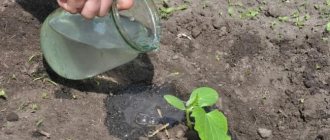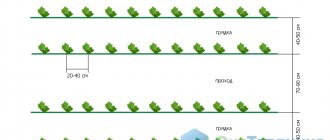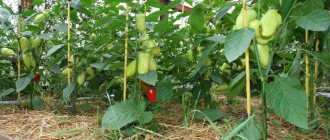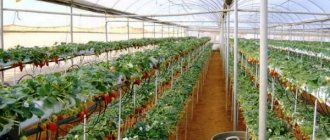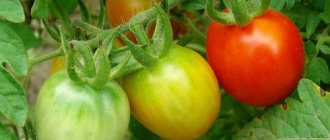Mulching is an agricultural technique that reduces moisture loss in the soil and improves the structure or composition of the soil.
In addition, mulch protects the plant from:
- overheating and freezing of roots;
- slugs;
- weeds.
Any garden and vegetable plants receive nutrition and substances necessary for growth in the form of aqueous solutions, which they absorb with the help of their roots.
Therefore, the lower the soil moisture, the more difficult it is for the roots to extract nutrients from the ground, so the soil must be constantly moistened.
However, frequent watering often leads to rot, so it is extremely important to increase the interval between waterings and reduce the rate of water loss from the soil.
Why do you need to mulch the soil?
Water leaves the soil in four ways:
- it is consumed by plant roots;
- it seeps into deep layers of soil;
- it evaporates due to heating by the sun's rays;
- she is carried away by the wind.
The influence of the first two points cannot be stopped or slowed down.
Therefore, it remains to influence the evaporation of water due to heating and wind blowing. Mulch, that is, material covering the ground, reduces the intensity of soil heating and also separates the soil surface from moving air, which is why water losses caused by these factors are reduced.
After rotting, mulch from natural materials is mixed with the soil and improves its structure , making the soil looser. Thanks to this, plant roots have easier access to water, because in loose soil the moisture is distributed more evenly, so it naturally compensates for what the roots have consumed.
In summer, mulch protects the soil from sunlight, so the plant roots do not overheat. In winter, the mulch layer protects the roots from frost, serving as a heat insulator.
If the water in the soil and roots freezes, it will increase in size and rupture the root cells , after which they will no longer be able to perform their functions normally. Thanks to the heat-insulating properties of mulch, the water in the roots does not freeze even in severe frosts, and in the spring it is easier for the plant to wake up from sleep and resume growth.
In addition, mulch protects the beds from slugs and weeds, because the former experience discomfort when moving on a very uneven surface, and the latter cannot grow normally through a thick mulch layer.
Read more about the purpose and use of mulch in the article Sawdust in the garden.
Advantages and disadvantages of mulching with sawdust
Mulching the soil with sawdust, that is, covering the surface of the earth with it, must be done with skill. This procedure is not always beneficial. Advantages:
- cheapness;
- retain moisture in the soil well;
- promote greater soil permeability;
- protect roots from temperature changes;
- when they decompose, organic substances are formed that nourish the earth with vital elements;
- retain heat in the soil and prevent it from freezing in severe winters;
- allow air to pass through;
- prevent the spread of weeds;
- prevent the berries from coming into contact with the soil, which means they reduce their spoilage;
- mulch is a home for beneficial microflora;
- mulching with pine sawdust prevents the development of fungal diseases and repels some pests;
- Coniferous sawdust, especially pine sawdust, drives away some pests and pathogens.
Despite the impressive list of advantages, mulching has its disadvantages:
- fresh sawdust affects the acidity of the soil, increasing it;
- large sawdust takes a long time to rot, and for the decomposition process they need nitrogen, which they take from the soil;
- Also, the decomposition period depends on the type of tree - sawdust from soft deciduous trees rots in 10–15 months, from pine and other conifers - 2–3 years;
- pine sawdust prevents the development of not only pathogenic microflora, but also beneficial ones.
Impact of wood waste on the earth: pros and cons
To understand how mulch from wood sawing waste differs from mulch from other materials, you need to understand how sawdust affects the soil.
The transformation of wood into humus (humus), that is, a substance suitable for absorption by plants, occurs due to the activity of a huge number of different bacteria and fungi .
This process occurs with any organic matter, due to which any plants, animals and other living organisms turn into humus after death.
During the life of microorganisms that ensure the decay of wood, various acids are released, only some of which are necessary to obtain humus.
The remaining acids do not affect the mechanical properties of the soil, but change the acid-base balance of humus, and then the soil with which it comes into contact.
This effect appears most strongly during the rotting of softwood sawdust, so even partially rotted waste from sawing wood acidifies the soil, changing the acid-base balance and making the soil unsuitable for some plants.
In addition, bacteria and fungi that ensure wood decay consume a lot of nitrogen, extracted both from sawdust and air, and from the soil with which wood waste comes into contact.
Therefore, with any use of sawdust, it is necessary to take into account the consumption of nitrogen by bacteria and the reduction in the level of this element in the soil.
Some of the acids secreted by bacteria and fungi pose a danger to young seedlings and shoots that have not yet had time to grow a strong bark that protects them from pathogens of various diseases.
Therefore, mulching young seedlings with fresh sawdust leads to damage to their skin and infection with pathogens of various diseases.
If a decrease in nitrogen levels and an increase in acidity can be compensated for with lime or ash, as well as nitrogen-containing fertilizers, then the only way to protect seedlings is to use only completely rotted material for mulching.
To compensate for the change in the acid-base balance of the soil after using sawdust mulch, the soil is sprinkled with ash, dolomite flour or slaked lime (fluff).
The alkali from these drugs reacts with acids , causing the latter to turn into salts with the release of water.
These processes occur slowly : therefore, both the increase in acidity and the decrease occur over several months.
That is why adding ash or other reagents along with applying a layer of sawdust mulch keeps the soil from changing acidity if the amount of reagents corresponds to the amount of acids released from wood waste.
SOIL ACIDIFICATION WITH SAWDUST
Due to the presence of organic waxy and resinous substances in the composition, sawdust, especially fresh and predominantly coniferous wood, acidifies the soil. While this plays a positive role on soils with an alkaline reaction, normal soil will suffer. Knowing this feature, it is necessary to additionally lime those areas where sawdust was used - 200-300 g of dolomite flour (ash) per 1 sq. m.
And one more thing - since sawdust is a moisture-intensive thing, refrain from using it during dry periods or water the soil to which it is added more.
Sawdust and its effect on acidity
How to prepare mulch?
For mulching, you can use various materials, the most popular of which are:
- polyethylene film;
- pulled or mown weeds;
- forbs (hay);
- straw;
- a mixture of various organic materials (weeds, hay, straw, etc.) with rotted manure or compost;
- needles;
- sawdust.
Plastic film, especially black or two-color, suppresses weed growth well and gives the bed a beautiful appearance, but has no effect on slugs.
In addition, on a hot summer day, the ground under such a film becomes dangerously hot, which often leads to the death of the roots.
The weak vapor permeability of this material leads to an increase in humidity on the surface of the earth and the appearance of mold and colonies of harmful bacteria, as well as to the rapid proliferation of woodlice.
In addition, the film cannot protect against frost, so other materials must be used along with it.
In any garden bed or greenhouse, various weeds constantly grow, which take away nutrients and moisture from cultivated plants, so they are weeded out or torn out.
Picked, mowed or torn out weeds can also be used as mulch, which protects against heat and cold better than film. However, such material often leaves weed seeds in the ground, which eventually germinate and then have to be pulled up or weeded out again.
A few days after laying on the ground, the pulled out weeds begin to turn into humus. Moreover, it is carried out by the same fungi and bacteria that ensure the rotting of sawdust.
As a result, the soil becomes slightly acidic, and the free acid damages the thin skin of the seedlings, making them vulnerable to disease.
Weeds rot much faster than sawdust due to the lower lignin content in the trunk, so they have time to completely rot before the onset of frost.
This leads to a decrease in the effectiveness of frost protection, because as a result of rotting, the thickness of the weed layer is greatly reduced .
The situation is the same with forb hay, straw or pine needles - these materials quickly rot and can also contaminate the area with seeds, which will lead to the appearance of extra plants in the garden bed or greenhouse.
Due to rapid decay, spring mulch cannot protect plant roots from frost, and due to the presence of mulch, weeds that can be used for autumn mulching do not grow in the beds, so you will have to buy hay or straw.
If you can buy these materials, they effectively protect plant roots from frost.
Since the rotting of any type of organic matter is ensured by the same fungi and bacteria as sawdust, their effect on the soil is approximately the same.
The only difference is that the dried stems of any herbs are much less dense than sawdust, therefore, with the same volume, they differ greatly in weight.
At the same time, the number of microorganisms that ensure decay, as well as the amount of acid they secrete and nitrogen consumed from the ground, is directly related to the mass. Therefore, the influence of mulch from hay, straw and pulled out weeds on the soil is much less than the influence that sawdust has.
In addition, the shape and structure of sawdust is better suited for loosening the earth than any other materials.
is more similar in size or very fine gravel.
Therefore, the soil with them allows water and air to pass through well. A mixture of any stems, as well as hay or straw with droppings/manure, compensates for the consumption of nitrogen by microorganisms, and lime or ash compensates for the increase in acidity.
However, even in this combination, these materials may not be as effective as as mulch.
After all, woodlice do not breed under the sawdust, and weeds do not grow, because the density of the mulch layer is much higher and the reserves in the weed seed are not enough to push through such a mass of wood waste.
If the total mass of weed, hay or straw mulch was equal to the mass of sawdust mulch, then the level of change in the acid-base balance, as well as nitrogen removal, would also be the same.
Therefore, the negative impact of sawdust and these materials on the soil is the same, but the benefits of sawdust are much greater.
The maximum effectiveness of any mulch, including winter mulch, is achieved only with the planting of green manure.
After all, even a mixture of rotted waste from sawing wood with droppings or manure cannot fully compensate for all the substances spent on the growth of cultivated plants.
But the combination of mulch from litter or manure with the planting of properly selected green manure completely compensates for all the substances spent and allows you to effectively grow cultivated plants in one area for many years.
Moreover, green manure and even the best mulching cannot replace each other because they have different purposes.
We have prepared links to several forums where users compare the effectiveness of using sawdust as mulch with other materials:
- Forumhouse.
- Our Dacha.
- Mastergrad.
Technology
Before treating the soil with mulch, you need to find out its acidity and, if necessary, adjust this parameter by adding additional components.
Preparation of material
Sawdust itself is not a fertilizer. On the contrary, they, like a sponge, suck elements from the soil, depleting it. Therefore, it is necessary to make mulch out of them. It is easy to prepare it with your own hands. Preparation begins with the acquisition of wood material. It must be of high quality, without pathogenic microorganisms and pests.
- Several buckets of sawdust are poured onto a plastic film and calcium nitrate is poured on top (70–80 g per 1 bucket of material). Then water it with water, cover it with film and leave it for a week.
- Urea is more often used to saturate the material with nitrogen. Fold it in a heap, water each layer with a urea solution (200 g per 10 liters of water), then cover with film. Every 14 days, the sawdust is shoveled so that it is saturated with oxygen. They are used when they turn black.
The preparation technology is to ensure that a sufficient number of microorganisms settle on the material, which will begin to process the wood into organic matter. To do this, it is necessary to maintain high humidity and temperature above +15°C. It takes time to prepare mulch, so it's best to do it in the spring or fall by making compost pits. Sawdust, manure and plant waste - tops, grass clippings, leaves - are placed in them in layers. If there is no time, then compost is prepared from fresh sawdust. For 1 bucket of sawdust take:
- superphosphate in granules - 30 g;
- ammonium nitrate - 40 g;
- calcium chloride - 10 g;
- slaked lime - 120 g.
The mixture is infused for 2 weeks.
Adding dolomite flour or ash to rotted sawdust neutralizes components that change the acidity of the soil.
Features of spring and summer mulching in open ground and greenhouses
In spring, annual crops are mulched immediately after planting. For this purpose, only sawdust from deciduous trees is used; oak sawdust cannot be used. Root vegetables - carrots, turnips, garlic - are sprinkled with mulch after thinning, when the tops of the plant have reached a height of 5–7 cm. The mulch layer is made 3–4 cm thick.
It is added to perennials after the soil has warmed up, having first removed the old mulch layer or dug it up with the soil. They are not mulched in the summer, as they do not have time to prepare for winter. Raspberries, currants, apple trees, and strawberry bushes are mulched in the spring before flowering. Sawdust should be added before the second decade of June, then by mid-summer there will be no trace left of the layer.
It is better to add mulch to the greenhouse in the spring, mixing it with other nutritional components - manure, urea. Plants are mulched when they begin to actively develop. This allows you to reduce the watering rate and protects the roots from overheating. Using pine sawdust in a greenhouse for growing tomatoes and cucumbers helps reduce the development of diseases and the number of harmful insects. The mulch layer should be 5–7 cm.
Preparing beds and plantings for winter
In the garden, high beds are made in which vegetable and flower crops grow well.
- Remove the top fertile layer and set it aside.
- A layer of mown grass, tops, and straw is laid on the resulting base.
- Sawdust, well moistened with a urea solution, is placed on it.
- Again, plant remains, which are covered with deposited soil.
To prevent the bed from crumbling around the perimeter, make sides from mown grass. Plants in such a bed need more water.
Preparation of raw materials
To prevent sawdust from harming the soil and plantings, they must be properly prepared to make mulch, completely or partially turning them into humus (humus).
To do this, you can use either clean wood waste of any species, or a mixture of sawdust with any feces, as well as nitrogen-containing fertilizers.
To begin the fermentation process, in which various bacteria and fungi will process the wood into humus, it is necessary to provide high humidity and a temperature above +15 degrees.
After all, the number of microorganisms must exceed a certain minimum threshold, after which they will be able to effectively process organic matter.
Adding manure or humus to the fermenting mass reduces the temperature requirements.
After all, excrement already contains most of the necessary microorganisms, and much more than the minimum amount.
After reaching a minimum amount, microorganisms begin to process the material, releasing thermal energy during their life processes, so the heap of a mixture of sawdust and litter/manure is warm inside even on frosty days.
By adding lime, ash or dolomite flour to rotting sawdust or a mixture with litter/manure, you will obtain a mulching material with excellent fertilizing properties and neutralize components that change the acidity of the soil.
This is especially important if you want to use material that is not completely rotted for mulching.
for natural decay of wood sawing waste, depending on temperature and humidity. Adding droppings/manure reduces the period of complete rotting to six months at above-zero temperatures or slight frost.
If, along with excrement, you add a drug that accelerates the growth of bacteria, then the sawdust will completely rot in 3-4 months.
For more information about these processes and the preparation of sawdust for application to the ground or use as mulch, read the article sawdust compost.
How to mulch beds in winter
To cover beds in winter, it is better to use sawdust in combination with manure or compost. The thickness of the layer is adjusted depending on the type of soil. For clayey, sandy loam and loam soils, 5 cm is enough, for sandy soils - at least 10 cm. Do not lay a massive layer of crushed shavings on heavy soils. This can lead to rotting of the substrate and the formation of mold.
With the onset of spring, the mulch in the berry gardens is not removed. Gradually rotting, it will become a good fertilizer for shrubs. It is permissible to loosen the earth along with sawdust. In case of soil acidification, the situation can be corrected by adding ash, slaked lime, and chalk. The improvement in soil fertility will be significant within 2-3 years.
Is it possible to use fresh sawdust, and how to apply it correctly?
When choosing waste from sawing wood for mulching certain plants, keep in mind that not completely rotted pine sawdust acidifies the soil much more than deciduous sawdust.
Therefore, hardwood sawdust is better suited for mulching with not completely rotted material.
If you wait until the wood waste is completely rotted, then there is no difference between coniferous and deciduous.
Each plant uses its own method of adding mulch, so the method of mulching peppers will not work for strawberries or raspberries.
In addition, mulching annuals differs from the same procedure in beds or greenhouses with perennial plants in that it is not necessary to protect the roots of the plants from frost.
What sawdust can be used
Crops react differently to the application of sawdust mulch.
- plants love chopped wood from deciduous trees, except oak, poplar and walnut. It is better not to use oak, as well as waste from poplar and walnut. They secrete substances that inhibit the growth of many crops;
- sawdust from coniferous trees acidifies the soil, so it is applied to plants that prefer an acidic environment - potatoes, greens, carrots, tomatoes and representatives of the pumpkin family;
- It is prohibited to use waste from chipboards, as they contain hazardous substances.
For mulching, material of different sizes is used.
- Very fine fractions are not used. It cakes into lumps and forms a hard crust on the surface.
- Large sawdust forms a loose and deep layer that is difficult to compact.
- Large shavings are used to insulate plants for the winter.
Sawdust in its pure form is sprinkled on paths in plots and flower beds, and on passages between beds. You should not cover the ground with fresh sawdust in the fall. This wood material has low thermal conductivity. If you cover cold ground with it, it will not thaw for a long time in the spring and will not warm up well. For mulch, it is better to use rotted or semi-rotted material that is colored light or dark brown.
Photo: © pinterest.com
To obtain a healthy potato harvest, after hilling, sprinkle the furrows with sawdust. They will help retain moisture and prevent weeds from germinating. Mulching raspberry bushes helps its root system to overwinter without negative consequences. Bushes of tomatoes, cucumbers, strawberries and many flowers - hydrangeas, roses, lupins, also respond well to this procedure.
Mulching must be combined with the application of nitrogen fertilizer.
For cucumbers, mulching with wood chips is practiced. Each bush is sprinkled in a circle, this protects the plant from sucking pests. Pine sawdust is used as biofuel. They are poured into the base of the cucumber bed, watered well with slurry and increased in height with soil.
Wood waste under the influence of manure will rot and generate heat all season long. Large wood shavings are placed in planting holes for grapes and flower vines. They act as a heat insulator, protecting plant roots from deep cold. It is better to use pine sawdust to mulch carrots; they will repel carrot flies. To insulate mulch, the “dry” method is most often used, which is suitable for most crops - clematis, grapes, rose bushes.
The advantage of this method is that the plants overwinter in a dry, warm place where excess moisture does not penetrate. They are covered with sawdust, covered with polyethylene on top and covered with earth. Events are held in late autumn.
Winter garlic needs mulching not to protect it from freezing, but to preserve soil moisture and prevent cracking of the ground. Therefore, a “wet” method of covering is suitable for garlic: mulch from shavings is sprinkled on the soil near the plants, without adding soil and without covering the beds with polyethylene. Mulching with pine sawdust protects garlic from diseases and pests.
You should not sprinkle such mulch on plants that like an alkaline environment - cabbage, beets. This will adversely affect their growth.
Photo: © gardeningknowhow.com
How can it be used as winter protection?
After harvesting, it is necessary to restore the nutrients spent on plant development and loosen the compacted soil.
If perennial plants are planted in beds or greenhouses, then their roots must also be protected from frost.
To do this, you can either increase the layer of summer mulch or add winter mulch. To cultivate the soil under annual plants, green manure is first planted, then the ground is covered with winter mulch, which loosens the soil and fills it with nutrients.
based on:
- sawdust of any species;
- droppings or manure;
- slaked lime;
- a drug that accelerates the decomposition of compost.
Moreover, you don’t even have to wait for the mulch to rot.
Indeed, thanks to a drug that accelerates the proliferation of bacteria, as well as droppings or manure, microorganisms that process organic matter will multiply and perform their function even at sub-zero temperatures.
Therefore, it is enough to scatter the thoroughly mixed composition throughout the greenhouse or garden bed, after which microorganisms will turn it into humus, which will loosen the soil and compensate for the loss of nutrients and microelements .
If you want to mulch a garden bed or greenhouse where perennial plants are planted, then consider the following:
- Only completely rotted material is suitable for laying directly on the ground;
- Partially rotted material is also suitable for laying on a layer of summer mulch, but around the plant trunks you will have to leave a free space of 10 cm in diameter, otherwise the plant trunk will suffer.
Therefore, it is not advisable to use material that is not completely rotted for perennial plants, because it will loosen the soil and provide it with nutrients, but will not be able to protect the plant roots from frost.
Completely rotted humus from sawdust and animal excrement is free from these shortcomings.
Nevertheless, winter mulching cannot fully replace the use of green manure, because even mulch based on the above composition compensates for the loss of only basic substances, but cannot replace what green manure restores.
Therefore, the maximum effect is achieved when winter mulching is carried out only after collecting green manure, and the green manure is scattered over the bed before laying the mulch layer.
Read more about the methods of mulching various plants, as well as the requirements for winter and summer mulch here: What can be mulched with sawdust. Material on using sawdust in the garden may also be useful.
IS IT POSSIBLE TO MULCH WITH SAWDUST?
One of the most common uses of sawdust in garden beds is mulching. What is the advantage of sawdust as mulch? First, they are widely available and cheap. Secondly, they have excellent thermal insulation properties and are well suited for covering plants for the winter. Thirdly, they can be used to prevent the fruits of some vegetable and berry crops from coming into contact with the surface of the earth. So, if you fill a bed with garden strawberries with sawdust, the berries will remain clean, and slugs will not be able to get to them.
The use of sawdust for mulching garden paths and wide row spacing is the best way to suppress the germination of weeds, while the wood material, due to its whiteness, protects the ground from overheating and excessive evaporation of moisture.
The tree trunks of trees and shrubs can be safely mulched even with fresh sawdust: this will help say goodbye to weeds and retain moisture in the soil. In the fall, the remnants of such mulch are dealt with simply: sprinkled with mineral fertilizers (the dose for the main filling plus a little nitrogen) or, after scattering manure on top, dig up the soil onto the bayonet of a shovel.
Conclusion
Sawdust is a good material for mulching any plants. When used correctly, this mulch protects plants from:
- drying out during the summer heat;
- frost;
- slugs and snails.
In addition, sawdust mulch loosens the soil in a garden bed or greenhouse and replenishes the loss of nutrients and microelements necessary for the normal development and fruiting of any plants.
The importance of sawdust in the household can hardly be overestimated, because it is also used as insulation for floors, ceilings and walls, and also serves as bedding for animals.
WHAT IS SAWDUST USED FOR?
With the right approach, sawdust can perform a variety of functions. They are used to cover plants during the cold season. They cover row spacing to suppress weeds. In the form of mulch, they fight moisture evaporation. When reclaiming land, they are added to heavy soils to loosen them. Sawdust is also suitable as a basis for preparing composts: it can be used to make a cushion with a layer of 20-30 cm. This substrate is indispensable for growing mushrooms - oyster mushrooms and champignons. Sawdust can also become drainage if you fill a drainage ditch with it.
As you can see, the benefits are obvious, all that remains is to learn how to use sawdust correctly.
The benefits and harms of using sawdust for the garden
To get rid of uncertainty, first of all, let's look at the benefits of sawdust:
- Loosening the soil. Mulching with this material makes the substrate “breathable” and softens the top layer of soil. A dense earthen crust does not form - the need for periodic loosening practically disappears.
- Absorption and retention of moisture. On the ridge with the addition of sawdust there will be a comfortable microclimate, the plants will not suffer from waterlogging.
- Weed barrier. Mulching with a dense sawdust layer is a powerful barrier to weeds.
- Natural fertilizer. This advantage comes with conditions: only in the case of rotten ones, they must be properly added to the substrate.
But at the same time, there is also harm from the use of this organic material:
- Acidification of the substrate. With large-scale application, the situation becomes so deplorable that it cannot be corrected even by applying mineral fertilizers or special preparations - nothing wants to grow on the site.
- Extracting nitrogen from the soil. Such fertilizer, mulch, and insulation are a real “thief” of nitrogen compounds in plantings.
But despite this harm, I constantly use sawdust and have no intention of giving up this valuable material. The fact is that each of the disadvantages can be simply leveled out.
As for substrate acidification, this effect is useful for a number of plants:
- coniferous plantings;
- blueberry;
- rhododendrons.
As for other plants, for them I neutralize the “acidic” sawdust with alkaline compounds. You can achieve optimal pH using simple materials:
- crumbled chalk;
- peat, wood ash;
- lime;
- dolomite flour;
- mineral compositions - superphosphate, potassium chloride, sodium nitrate, ammonium sulfate, calcium nitrate and potassium sulfate.
My procedure is simple: I add them to the soil along with one of the alkaline preparations. Before this, I first check the acidity of the soil using litmus papers, which are also available in garden centers today.
The disadvantage associated with the “theft” of nitrogen can be corrected even more simply: I dilute an aqueous solution of urea and calcium nitrate, and wait until the fertilizer is completely dissolved. Then I impregnate the sawdust with this composition.
Ways to use sawdust in the country
And now I will share with you several effective and proven methods for using sawdust in the garden, which I have successfully tested from my own experience.
For mulching
They cope excellently with the main tasks of mulching material:
- retain moisture in the substrate;
- stimulate the growth of lateral, adventitious roots;
- inhibit the development of weeds;
- protect plantings from pathogens found in the soil;
- stop erosion and soil erosion;
- prevent the appearance of an earthen crust;
- prevent both excessive heating of the earth in summer and freezing in winter;
- contribute to softening and loosening of the soil.
mulching with sawdust
Before using them as mulch, I do not forget to prepare them:
- In a sunny area I spread thick polyethylene and spread it on it in a thin layer.
- I evenly sprinkle with dry urea (200 g of fertilizer per bucket of sawdust).
- I spill about 10 liters of water.
- I cover the top with the same thick polyethylene and secure it.
- I leave it to “prepare” for 2 weeks.
After maturation, I already use sawdust mulch: I scatter the material over the ridges in a layer of 3-5 cm. As an option, I mix this wood material with ash.
This mulch is universal and suitable for all plantings. But the best option is for garden strawberries. In the fall, do not collect rotted sawdust - just dig it up with the ground.
Excellent fertilizer
I also use them as a component of complex organic fertilizer: the second component is manure. To prepare the fertilizer, I follow a simple scheme:
- Before adding it to the pile, I fill the wood component with water. Alternatively, slurry or liquid food waste is used.
- For 1 cubic meter of sawdust - 100 kg of cow manure, 10 kg of chicken droppings. You can add 2-3 buckets of garden soil inhabited by earthworms.
- I mix the mixture thoroughly and leave it to rot for a year.
- When preparing fertilizer, I do not forget to add dry grass, leaves, hay, and food waste. I periodically water the pile with water for better debate.
- If desired, you can additionally add nitrogen compounds that promote the decomposition of sawdust - they are sold in garden centers. Ordinary urea, ammonium sulfate, lime-ammonium nitrate, “Gumi-omi”, etc. are also suitable.
- To prevent precipitation from washing away this manure fertilizer, I cover the top of the mass with slate or strong polyethylene.
For beds
They help to slightly raise the level of the ridge located in the lowland. Follow the instructions here:
- At the site of the future bed, I dig a trench approximately 25 cm deep.
- I pre-prepare the sawdust by soaking it in urea or another alkaline solution.
- I cover the bottom of the hole tightly with hay or dry grass.
- Then I make a mound of already prepared sawdust.
- I lay a layer of fertile garden soil on top of the wood material.
In this case, the bed can also be mulched. In the fall, dig them up along with the soil.
When germinating seeds
Sawdust is also an excellent material for germinating planting material. The seedlings themselves should not be grown in them - there will not be enough nutrients for the development of young plants.
I present instructions for germination:
- I prepare a suitable container and fill its bottom with a thin layer of sawdust.
- I spread the seeds on the wood material, maintaining a sufficient distance between them.
- I sprinkle it with an even thinner layer.
- I close the container with a lid or wrap the container in plastic.
- For germination, I take it to a dark and warm (25-30° C) place.
- As soon as the first shoots appear, I remove the shelter. Then I move the container to a cooler place and sprinkle the seedlings with a light layer of fertile substrate.
- As soon as the seedlings have their first true leaves, I transplant them into separate containers, already completely filled with fertilized soil.
This method of germination is good for its versatility - suitable for almost any seed.
For early potato harvest
It is the sawdust that helps me harvest new potatoes earlier than my neighbors. I'll share my secret with you:
- I buy an early variety of potatoes or take the tubers left over from that year and germinate the nodules in the light.
- I soak them in water, after which I place the wood material in a box - a 10-centimeter layer is enough.
- I place the potatoes directly on the sawdust, with the sprouts pointing upward.
- I sprinkle the tubers with another layer of sawdust (2-3 cm).
- I wait until the sprouts reach a length of 6-8 cm. All this time I make sure that the sawdust remains moist.
- I plant the prepared potatoes in the holes according to the usual pattern and completely cover them with soil.
- If it’s still cool, I insulate the plantings with straw, hay or cover them with non-woven material.
This measure is enough to harvest the first potato harvest several weeks ahead of schedule.
potato harvest
Warming plants
Gardeners have come up with several ways to insulate plantings using sawdust:
- Thick bags are filled with wood material and then laid out around the plants. This measure allows you to protect sawdust from freezing, getting wet, and makes it inaccessible to rodents.
- A frame is erected over the perennial plant - use a plank box without a bottom. Inside it is filled to the top with sawdust, which covers the planting. Then the entire structure is wrapped in thick polyethylene. For greater protection from frost, this structure is covered with earth.
I do not recommend insulating plants with sawdust, simply sprinkling them on the plantings. In this case, wait for the mice to visit. In addition, the wood material can get wet and freeze - it will do more harm than good.
Types of sawdust and their features of use for the garden
To achieve the desired result, you have to add not a bucket or one bag to the soil, but a much larger volume. Here the composition of the mass plays an important role, because the time of their decomposition depends on the material from which sawdust comes, how the composition of the soil will change, and what positive and negative aspects can accompany this process. It is most convenient to consider the division of the qualities of this material based on its origin from coniferous or deciduous trees.
– conifers
To accurately determine the composition of the sawdust mass, it is enough to determine what type they belong to - coniferous or deciduous. And although there are also qualitative differences among coniferous species, for the most part pine and spruce sawdust are used for application.
This material has several differences by which it can be identified:
- Sharp specific pine smell;
- It has a characteristic sticky feeling to the touch due to the high resin content;
- The mass retains its odor for a long time, even if it is a product of processing boards or logs after long-term storage;
- It has a white or white color with a slight yellow tint.
The most commonly used sawdust is:
- Pine;
- Spruce;
- Cedar;
- From larch;
Coniferous trees are characterized by a high content of resins in the wood, which makes them a valuable building material. On the other hand, tree resin prevents the rapid decomposition of fibers in the soil. Therefore, the main use of softwood raw materials is mulching and filling paths. When rotting in open ground conditions, pine sawdust absorbs a large amount of nitrogen, which retards plant growth. The most unpleasant thing about using softwood sawdust is that in areas where it is scattered, the soil changes its acidity. When using pine bedding for 3-4 seasons, the soil becomes acidified, which leads to a decrease in the yield of most vegetable crops.
– deciduous
Deciduous trees, unlike coniferous trees, are more popular as feedstock for fertilizer. First of all, this is due to the low resin content in the fibers. The second point that you need to pay attention to is the relatively fast decomposition time of fibers of birch, maple, chestnut, and fruit trees. On average, 6-8 months are enough for birch sawdust to completely decompose in open ground.
Sawdust from deciduous trees is used both for applying to the soil in the form of fertilizers and for other operations:
- Mulching;
- Composting;
- filling paths;
- storage of root crops;
- seed germination;
- storage during transportation of plant root systems.
There is no preparation of hardwood sawdust before applying it to the soil as a regular fertilizer. When composting, the material is sprinkled with manure and chicken droppings. But when filling garden paths, it is recommended to mix sawdust from coniferous and deciduous trees to reduce the rate of decay of the mass.
However, it is worth noting that hardwood fibers also, when rotting, take nitrogen from the soil and slightly acidify the soil. These are, perhaps, all the disadvantages of this type of material.
